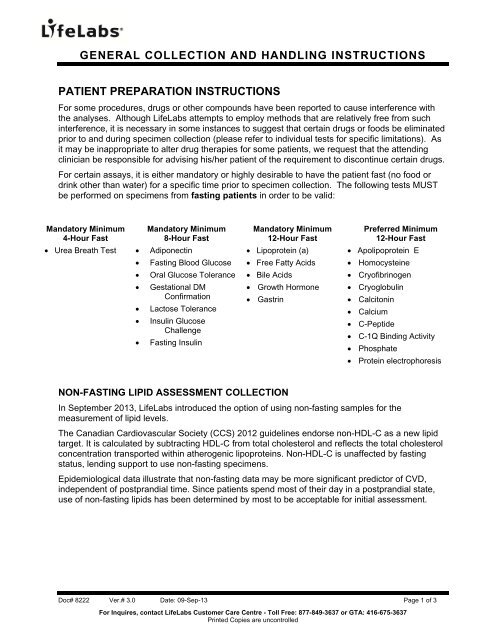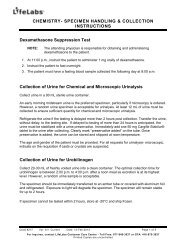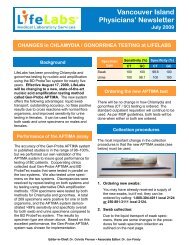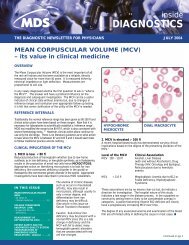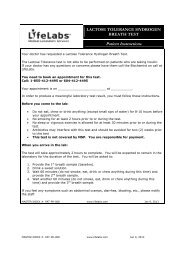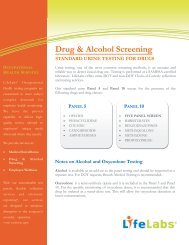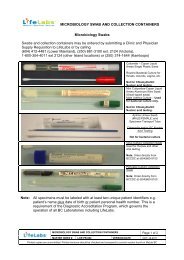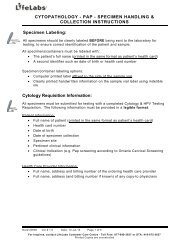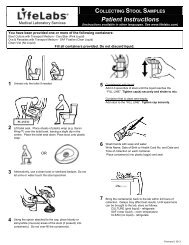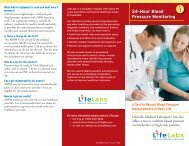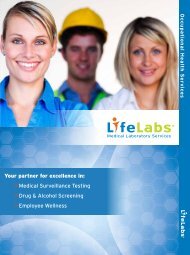General Collection and Handling Instructions - Lifelabs
General Collection and Handling Instructions - Lifelabs
General Collection and Handling Instructions - Lifelabs
You also want an ePaper? Increase the reach of your titles
YUMPU automatically turns print PDFs into web optimized ePapers that Google loves.
GENERAL COLLECTION AND HANDLING INSTRUCTIONS<br />
PATIENT PREPARATION INSTRUCTIONS<br />
For some procedures, drugs or other compounds have been reported to cause interference with<br />
the analyses. Although LifeLabs attempts to employ methods that are relatively free from such<br />
interference, it is necessary in some instances to suggest that certain drugs or foods be eliminated<br />
prior to <strong>and</strong> during specimen collection (please refer to individual tests for specific limitations). As<br />
it may be inappropriate to alter drug therapies for some patients, we request that the attending<br />
clinician be responsible for advising his/her patient of the requirement to discontinue certain drugs.<br />
For certain assays, it is either m<strong>and</strong>atory or highly desirable to have the patient fast (no food or<br />
drink other than water) for a specific time prior to specimen collection. The following tests MUST<br />
be performed on specimens from fasting patients in order to be valid:<br />
M<strong>and</strong>atory Minimum<br />
4-Hour Fast<br />
M<strong>and</strong>atory Minimum<br />
8-Hour Fast<br />
Urea Breath Test Adiponectin<br />
Fasting Blood Glucose<br />
Oral Glucose Tolerance<br />
Gestational DM<br />
Confirmation<br />
Lactose Tolerance<br />
Insulin Glucose<br />
Challenge<br />
Fasting Insulin<br />
M<strong>and</strong>atory Minimum<br />
12-Hour Fast<br />
Lipoprotein (a)<br />
Free Fatty Acids<br />
Bile Acids<br />
Growth Hormone<br />
Gastrin<br />
Preferred Minimum<br />
12-Hour Fast<br />
Apolipoprotein E<br />
Homocysteine<br />
Cryofibrinogen<br />
Cryoglobulin<br />
Calcitonin<br />
Calcium<br />
C-Peptide<br />
C-1Q Binding Activity<br />
Phosphate<br />
Protein electrophoresis<br />
NON-FASTING LIPID ASSESSMENT COLLECTION<br />
In September 2013, LifeLabs introduced the option of using non-fasting samples for the<br />
measurement of lipid levels.<br />
The Canadian Cardiovascular Society (CCS) 2012 guidelines endorse non-HDL-C as a new lipid<br />
target. It is calculated by subtracting HDL-C from total cholesterol <strong>and</strong> reflects the total cholesterol<br />
concentration transported within atherogenic lipoproteins. Non-HDL-C is unaffected by fasting<br />
status, lending support to use non-fasting specimens.<br />
Epidemiological data illustrate that non-fasting data may be more significant predictor of CVD,<br />
independent of postpr<strong>and</strong>ial time. Since patients spend most of their day in a postpr<strong>and</strong>ial state,<br />
use of non-fasting lipids has been determined by most to be acceptable for initial assessment.<br />
Doc# 8222 Ver.# 3.0 Date: 09-Sep-13 Page 1 of 3<br />
For Inquires, contact LifeLabs Customer Care Centre - Toll Free: 877-849-3637 or GTA: 416-675-3637<br />
Printed Copies are uncontrolled
GENERAL COLLECTION AND HANDLING INSTRUCTIONS<br />
PHLEBOTOMY AND LABELING INSTRUCTIONS<br />
For Clients that collect specimens from their patients in their facility, proper collection <strong>and</strong> h<strong>and</strong>ling<br />
of those specimens is essential to maintain their integrity.<br />
Phlebotomists need to be reminded that:<br />
Specimens should be collected <strong>and</strong> labeled one patient at a time to avoid misidentification.<br />
Clear identification of specimens using at least 2 unique identifiers will ensure a test result<br />
is attributed to the correct person.<br />
Specimens are drawn in the correct order. This will prevent cross-contamination that may<br />
lead to inaccurate results or contaminated blood cultures.<br />
The correct number of tubes <strong>and</strong> appropriate tube types are collect for the required tests.<br />
Proper mixing of each tube is essential to prevent delay or incomplete clotting or platelet<br />
clumping<br />
They need to record on the requisition the time <strong>and</strong> date of collection<br />
They need to record their initials on the requisition in the top left h<strong>and</strong> corner<br />
For detailed test h<strong>and</strong>ling requirements, visit our web site www.lifelabs.com.<br />
Look for ‘Healthcare Clients – Ontario’ <strong>and</strong> click on ‘Test Information Directory’<br />
It is important to include relevant clinical information on specimen requisition forms, allowing the<br />
laboratory to appropriately process <strong>and</strong> report results on submitted specimens. The table below<br />
summarizes essential clinical information related to commonly ordered tests.<br />
Microbiology<br />
All specimens<br />
Test<br />
Wound Swabs/Sterile Sites/Chlamydia<br />
Parasitology<br />
Blood cultures<br />
Genital<br />
Hematology<br />
Heparin<br />
Lymphocyte markers<br />
(Flow Cytometry)<br />
Molecular Diagnostics<br />
Human Papillomavirus (HPV)<br />
Therapeutic Drug Monitoring<br />
Aminoglycosides/Vancomycin<br />
Other TDM<br />
Essential Clinical Information<br />
Pregnancy status, immune status, antibiotic allergies,<br />
previous failed antibiotic treatments, present antibiotic<br />
treatment, if applicable.<br />
Body site<br />
Travel history, immune status<br />
Prolonged incubation time required, if applicable (i.e.,<br />
endocarditis, Brucellosis, fever unknown origin)<br />
Vaginal, cervical or rectovaginal site<br />
Type <strong>and</strong> name of heparin administered<br />
Complete LifeLabs “Request for Lymphocyte Marker<br />
Analysis By Flow Cytometry” Form<br />
Include clinical diagnosis<br />
PAP smear history of ASCUS<br />
Peak/Trough collection, if applicable, time since last<br />
dose<br />
Time since last dose<br />
Doc# 8222 Ver.# 3.0 Date: 09-Sep-13 Page 2 of 3<br />
For Inquires, contact LifeLabs Customer Care Centre - Toll Free: 877-849-3637 or GTA: 416-675-3637<br />
Printed Copies are uncontrolled
GENERAL COLLECTION AND HANDLING INSTRUCTIONS<br />
STORAGE AND TRANSPORTATION OF SPECIMENS INSTRUCTIONS<br />
Specimens should be collected, h<strong>and</strong>led, stored <strong>and</strong> transported in accordance with LifeLabs<br />
h<strong>and</strong>ling instructions. In general, specimens which must be frozen to maintain integrity should be<br />
procured in a LifeLabs Patient Service Centre. Most coagulation assays require freezing of the<br />
plasma but INR specimens should be stored <strong>and</strong> transported at room temperature <strong>and</strong> not frozen.<br />
Specimens collected in Serum Separator Tube (SST – gold top tube) should be allowed to clot<br />
while in a vertical position for 30 minutes then centrifuged as soon as possible. Any specimen<br />
collected in a plain serum tube (red top tube), e.g., digoxin, should be allowed to clot for 30<br />
minutes, centrifuged <strong>and</strong> the serum separated into a secondary aliquot tube prior to transportation.<br />
Potassium <strong>and</strong> glucose are particularly sensitive to delay in separation. Significant increase of<br />
potassium will be observed if specimen is not properly centrifuged. To avoid a decrease in<br />
glucose due to glycolysis, gray top tube must be used for all glucose requests.<br />
When proper collection, h<strong>and</strong>ling <strong>and</strong> identification protocols have not been adhered to, specimens<br />
will be rejected. Proper specimen h<strong>and</strong>ling <strong>and</strong> identification are fundamental to patient safety.<br />
Doc# 8222 Ver.# 3.0 Date: 09-Sep-13 Page 3 of 3<br />
For Inquires, contact LifeLabs Customer Care Centre - Toll Free: 877-849-3637 or GTA: 416-675-3637<br />
Printed Copies are uncontrolled


